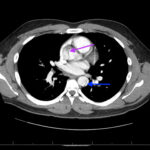Case Report: Thoracic Aortic Dissection in a Previously Healthy Male with an Unusual Inciting Factor
ABSTRACT:
Thoracic aortic dissection is a life-threatening emergency that can be easily overlooked in the absence of commonly associated risk factors, such as hypertension, connective tissue disease, cocaine use, and older age. The classic presenting symptom of abrupt-onset, severe “tearing” or “ripping” chest pain may be an unreliable finding. We present the case of a 30-year-old previously healthy male with no known risk factors who turned around to sanitize after having a bowel movement when he began feeling tight, severe back pain. After ruling out common etiologies of acute back pain with a negative computed tomography (CT) scan, point-of-care ultrasonography was performed which revealed a crescent-shaped flap within the abdominal aorta. Follow-up computed tomography angiogram (CTA) confirmed an extensive Stanford type A aortic dissection. Remarkably, the patient remained hemodynamically stable throughout his emergency department (ED) visit without developing any new pulse deficits or heart murmurs. It is a good reminder to maintain a high index of suspicion for aortic dissection in patients presenting with acute back pain without any classic risk factors. We also review the most recent literature regarding aortic dissection in young adults and ultrasonography for aiding diagnosis in the ED.
Topics:
Thoracic aortic dissection, aortic dissection risk factors, CT scan, point-of-care ultrasonography.






